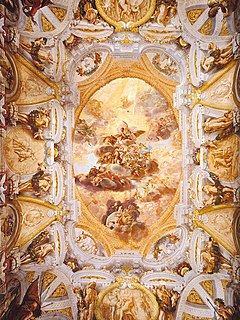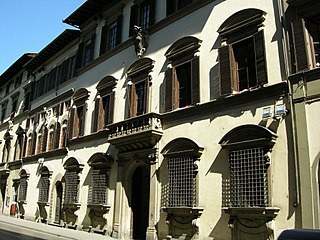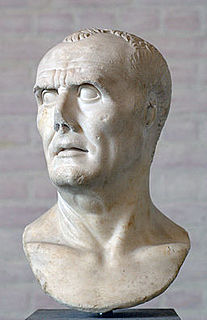
Palazzo Pamphilj, also spelled Palazzo Pamphili, is a palace facing onto the Piazza Navona in Rome. It was built between 1644 and 1650.

The Palazzo Barberini is a 17th-century palace in Rome, facing the Piazza Barberini in Rione Trevi. Today it houses the Galleria Nazionale d'Arte Antica, the main national collection of older paintings in Rome.

Palazzo Braschi[paˈlat.tso ˈbras.ki] is a large Neoclassical palace in Rome, Italy and is located between the Piazza Navona, the Campo de' Fiori, the Corso Vittorio Emanuele II and the Piazza di Pasquino. It presently houses the Museo di Roma, the "museum of Rome", covering the history of the city in the period from the Middle Ages through the nineteenth century.

The Palazzo Buonaccorsi is an 18th-century aristocratic palace, now the civic museum of the town, located on Via Don Minzoni 24 in the historic center of Macerata, region of Marche, Italy.

Giuseppe Bartolomeo Chiari, also known simply as Giuseppe Chiari, was an Italian painter of the late-Baroque period, active mostly in Rome.

Palazzo Carignano is a historical building in the centre of Turin, Italy, which houses the Museum of the Risorgimento. It was a private residence of the Princes of Carignano, after whom it is named. Its rounded façade is different from other façades of the same structure. It is located on the Via Accademia delle Scienze.
Giovanni Giacomo Barbelli was an Italian painter of the Baroque period, active in Brescia.

The Museo internazionale e biblioteca della musica is a music museum and music library in the Palazzo Aldini Sanguinetti, in the historic center of Bologna, Italy.

The Palazzo Felicini is a Renaissance style palace in Via Galliera 14 in central Bologna, Italy.

The Palazzo Pepoli Campogrande, also known as Palazzo Pepoli Nuovo, is a Baroque style palace on Via Castiglione 7 in central Bologna, region of Emilia-Romagna, Italy. In 2015, it served as a public art gallery for late-Baroque art. Across the Via, rises the medieval Palazzo Pepoli Vecchio, also once pertaining to the same family, which now serves as a museum of the history of Bologna.

The Palazzo Ranuzzi, also called Palazzo Baciocchi or Palazzo Ruini, is a Baroque style palace in central Bologna. It is now houses the Court of Appeals of Bologna.

Palazzo Malvezzi Campeggi is a Renaissance palace located on Via Zamboni number 22, at the corner (southwest) with Via Marsala, in central Bologna, region of Emilia Romagna, Italy. It stands across from San Giacomo Maggiore, and just northeast of the Palazzo Magnani. It presently houses the Law Faculty of the University of Bologna.

The Museo Nazionale di Palazzo Mansi is one of the two main art museum hosting tapestry collections and mainly post-19th century art collections owned by the city of Lucca, Italy. The collection is displayed in the Baroque palace, formerly belonging to the Mansi family, and located in central Lucca. Many of the original room decorations remain in place.

The Palazzo Fantuzzi is a monumental Renaissance style palace located on Via San Vitale number 23 in central Bologna, region of Emilia-Romagna, Italy. The palace is also known as the Palazzo degli Elefanti for its sculpted decoration, and it stands near the church of Santi Vitale e Agricola.

The Palazzo Capponi Covoni is a Baroque architecture palace in Florence, region of Tuscany, Italy. There are apparently three other palaces once associated with the Capponi family:
The Palazzo della Prefettura also called the Palazzo Scotti di Vigoleno is a Baroque architecture-style palace in central Piacenza, region of Emilia-Romagna in Italy. The palace houses the offices of the provincial administration.

The Palazzo Zambeccari at 11 Via Carbonesi is a Neoclassical urban palace in central Bologna, region of Emilia-Romagna, Italy. It is located diagonal to the facade of San Paolo Maggiore, and in 2015 was home to offices of the Banco Populare di Milano SCRL.
The Palazzo Cospi Ferreti is a Renaissance style palace located on Via Castiglione #21 in central Bologna, region of Emilia-Romagna, Italy.

The Palazzo Malvezzi de' Medici is a Renaissance-style palace located on Via Zamboni #13 in central Bologna, Italy. The palace now houses the offices of the Provincial Administration.
The Palazzo Moroni is an urban aristocratic palace located on Via Porta #12 in the historic center of the upper town of Bergamo, Italy. The palace with its Baroque interior decorations and is a civic art museum, as well as used for cultural functions. The building is presently managed by the Fondazione di Palazzo Moroni in conjunction with the city after a donation by former Count Antonio Moroni.






















